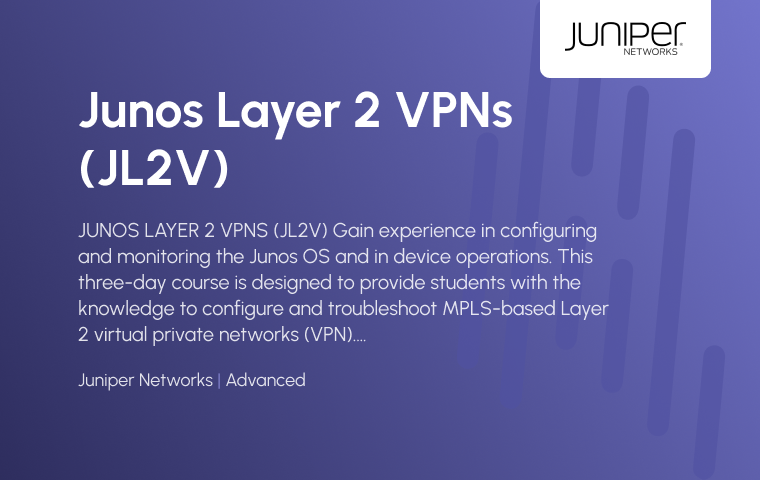
Junos Layer 2 VPNs (JL2V)
This two-day course is designed to provide students with MPLS-based Layer 2 virtual private network (VPN) knowledge and configuration examples. The course includes an overview of MPLS Layer 2 VPN concepts, such as BGP Layer 2 VPNs, LDP Layer 2 circuits, FEC 129 BGP autodiscovery, virtual private LAN service (VPLS), Ethernet VPN (EVPN), and Inter-AS Layer 2 VPNs. These concepts are put into practice with a series of in-depth hands-on labs, which will allow participants to gain experience in configuring and monitoring Layer 2 VPNs, VPLS, and EVPNs on Junos OS devices utilizing the Junos OS Release 16.2R1.6.
Virtual Classroom Live
Prerequisites
- Intermediate-level networking knowledge
- Understanding of OSPF, IS-IS, BGP, and Junos policy
- Experience configuring MPLS label-switched paths using Junos
- Completion of prerequisite courses:
- Introduction to the Junos Operating System (IJOS)
- Junos Service Provider Switching (JSPX)
- Junos Intermediate Routing (JIR)
- Junos MPLS Fundamentals (JMF)
Target Audience
What You’ll Learn
Course Outline
Labs Outline
Related Certifications
- Define the term virtual private network.
- Describe the business drivers for MPLS VPNs.
- Describe the differences between Layer 2 VPNs and Layer 3 VPNs.
- List advantages for the use of MPLS Layer 3 VPNs and Layer 2 VPNs.
- Describe the roles of a CE device, PE router, and P router in a BGP Layer 2 VPN.
- Explain the flow of control traffic and data traffic for a BGP Layer 2 VPN.
- Configure a BGP Layer 2 VPN and describe the benefits and requirements of over-provisioning.
- Monitor and troubleshoot a BGP Layer 2 VPN.
- Explain the BGP Layer 2 VPN scaling mechanisms and route reflection.
- Describe the Junos OS BGP Layer 2 VPN CoS support.
- Describe the flow of control and data traffic for an LDP Layer 2 circuit.
- Configure an LDP Layer 2 circuit.
- Monitor and troubleshoot an LDP Layer 2 circuit.
- Describe the operation of FEC 129 BGP autodiscovery for Layer 2 VPNs.
- Configure a FEC 129 BGP autodiscovery Layer 2 VPN.
- Monitor and troubleshoot a FEC 129 BGP autodiscovery for Layer 2 VPNs.
- Describe the difference between Layer 2 MPLS VPNs and VPLS.
- Explain the purpose of the PE device, the CE device, and the P device.
- Explain the provisioning of CE and PE routers.
- Describe the signaling process of VPLS.
- Describe the learning and forwarding process of VPLS.
- Describe the potential loops in a VPLS environment.
- Configure BGP, LDP, and FEC 129 BGP autodiscovery VPLS.
- Troubleshoot VPLS.
- Describe the purpose and features of Ethernet VPN.
- Configure Ethernet VPN.
- Monitor and troubleshoot Ethernet VPN.
- Describe the Junos OS support for hierarchical VPN models.
- Describe the Junos OS support for Carrier-of-Carriers VPN Option C.
- Configure the interprovider VPN Option C.
- Describe the Junos OS support for multisegment pseudowire for FEC 129.
- Describe and configure circuit cross-connect (CCC).

